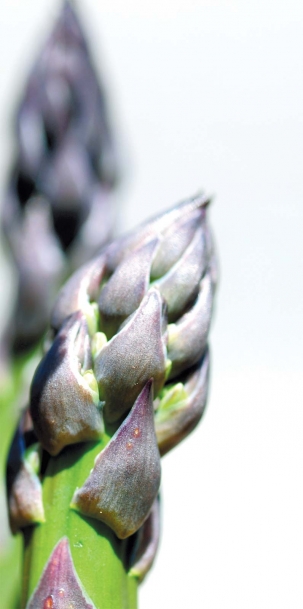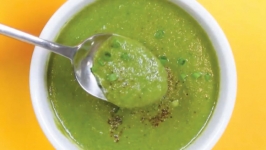Spring Spears - Asparagus Starts the Season with Healthy Abundance
After months of cold temperatures and hearty meals, nothing is quite as satisfying as the lush green taste of a fresh spring vegetable. Asparagus is one of the harbingers of the season, and its growing power, and nutritional profile, is exceptional.
While asparagus can be planted in the fall, most prefer to start it in the spring when the soil can be worked.
“You can plant asparagus by seed, but many opt to start with an asparagus crown, which is a cluster of roots,” says Alec Gioseffiof Cherry Valley Cooperative in Princeton.
“It’s important to plant it where it can spread, since its shoots do not grow linearly,” he explains, noting that it takes time before asparagus can be properly harvested.
“It takes three to four seasons before an asparagus patch yields a worthy crop and you start getting spears the size of your thumb,” he says. As tempting as it may be to pick asparagus spears in the first few years, it’s best to wait until the plant gets established; picking early will weaken future crops.
As with most things, patience pays off.
“When the crop is mature enough to pick, harvesting can be a daily task, especially on a warm spring day. You can almost see asparagus grow before your eyes,” says Gioseffi.
In addition, the more you cut, the more you get.
“The plant wants to procreate and go to flower and seed. By cutting it, you’re making it want to produce more stalks so that it can get to the seeding stage of its life cycle,” he explains.
Harvesting generally stops around Memorial Day, after which the asparagus is left alone to mature into a lacy, fern-like plant that will come back the following year and many more after that. An established asparagus patch can produce for 10 years or more.
Though it’s a plant that keeps on growing, it owes its current longevity to the help of scientists.
“Beginning in the 1940s, Rutgers started a breeding program to develop desirable traits in asparagus and to deter common threats like fungal diseases like Rust Disease and Fuserium,” says Tom Ombrello, senior professor of biology at Union County College in Cranford.
“In addition, all-male hybrids were developed, which yield more spears because [they don’t] need to allocate energy for seed and fruit production, which translates into more spears the following year,” he says.
A few of the namesake hybrid varieties include Jersey Giant, Jersey Knight and Jersey Supreme.
As far as consuming asparagus, there’s a lot to love.
“It’s delicious grilled, baked, boiled, stir-fried, sautéed—and [it] can be added to everything from salads to eggs and pasta dishes and more. It’s as versatile as it is nutritious,” says Riva Touger-Decker of the Division of Nutrition at Rutgers School of Dental Medicine in Newark.
“A half a cup of cooked asparagus contains about 50% of your daily value of vitamin K, which helps with calcium absorption, as well as blood clotting and coagulation,” she says. “In addition, asparagus is high in folate, which is important for cell growth, red blood cell formation and cognitive function.” She also adds that folate is especially important for pregnant women.
“Folate has been shown to decrease birth defects, which is why folate fortification is in so many grains and there are increased requirements for pregnant women,” she says, noting that a half-cup serving of asparagus contains 30% of your daily value, or 20% of the daily value for pregnant women.
“It’s a nutrient that’s important for all life stages.”
In addition, asparagus boasts some interesting traits when it comes to urinary health.
“Some people experience an odor to their urine after consuming asparagus, and this is due to the presence of asparagusic acid, which the body breaks down into sulfuric compounds upon elimination,” Touger-Decker says, adding that it’s not something everybody experiences. Additional compounds in asparagus benefit kidney health. “An amino acid called asparagine helps prevent kidney stones, as well as increases urine production,” she says, adding that the naturally high water content in asparagus further aids this benefit.
So, as spring’s bounty emerges, make sure asparagus is on your list—a vibrant spring vegetable with a bunch of benefits.
DID YOU KNOW?
White asparagus gets its unique hue because it is covered with straw or mulch as it grows, which prevents it from photosynthesizing and turning green.
“Don’t underestimate how good fresh asparagus is raw. My favorite way to eat it is to shave it with a vegetable peeler, then toss it with lemon, white pepper and olive oil.”
—Alec Gioseffi , Cherry Valley Cooperative, Princeton
ASPARAGUS PLANTING TIPS
(Courtesy of Alec Gioseffiof Cherry Valley Cooperative in Princeton.)
Plant asparagus crowns in holes that are 4 to 8 inches deep and 4 to 5 inches wide. Spread out the roots as much as possible, then cover with soil. Plant the crowns about l2 to 18 inches apart. Cover your asparagus patch with straw to help with weed suppression. It takes two to three years before a planting will yield a worthy crop, where the stems become the size of your thumb.












